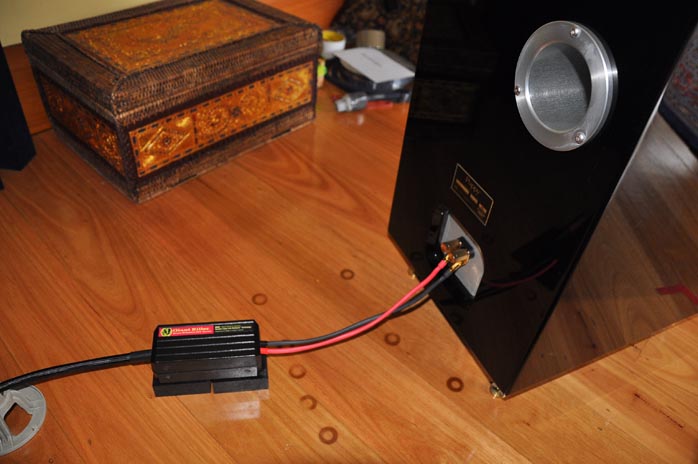This review page is supported in part by the sponsors whose ad banners are displayed below |
 |
Pole dancing
I started by introducing the MMS speaker cable with the start-up GK3 module first. The cable was certainly powerful in the bass register and very evenly balanced throughout the rest of the spectrum. The MMS brought a sense of ease and midrange fluidity which I really appreciated. Resolution and instrument separation were very good but fell behind the extremely resolute Cerious Technologies speaker cable. The GK3 MMS presented the high frequencies in a somewhat polite manner. What I mean here is that riding cymbal work or bells and triangles for example were ever so slightly muted when compared to the Cerious. Mind you, that’s not to say that the treble sounded any less real. It was simply a tad laid back and thus perhaps less prominent within the mix. Nevertheless, the GK3 as a stand-alone cable was very good indeed in its overall performance, albeit with a subtly polite—or dark—high-frequency balance.
Adding the GK2 module improved things in terms of high and low frequencies. It was not a night and day difference— when it comes to cables, few differences are that dramatic – but this added module made definite inroads into more extended territory. What’s more, image specificity became subtly more clear cut; instruments seemed to be more layered and more sharply focused in a somewhat larger soundstage.
|
|
But it was the final GK1 module that brought home the bacon. With the GK1 installed, the reproduction took significant steps towards a more transparent, real-sounding and convincing reproduction. For starters, the overall presentation became fuller and more weighty but not necessarily in terms of bass power—although that too was improved over the already very good GK2—but by way of a meatier and more authoritative sound. These more ‘meat-on-the-bones’ sonics did in no way detract from the GK1’ed cable’s ability to surgically separate instruments in a way that not only allowed easy audible distinctions but also retained the musicians’ intent in presenting a coherent musical event.
Dynamic expression in both the micro and macro areas was quite outstanding. The anal-retentive minutiae that audiophiles relentlessly pursue came through in a natural and unaffected way, jumping out of the mix quite surprisingly at times. Similarly, macro dynamic contrasts were allowed to extend to their fullest expression, with well-recorded drumming in particular being startlingly visceral.
|
|
|
The straightforward MPC interconnect cable has sonic prowess of its own and worthwhile practical advantages too. Logistically, the MPC’s thin gauge, flexibility and light weight make it a snap to guide and run around the back of the rack in utter contrast to the marvelous sounding but unyielding and thoroughly impractical Cable Research Labs (CRL) Gold I use as reference. Having easily run the cables in and around the various components, the MPC cable performed quite well if not to the exalted standard of the CRL. In fact, considering its price, the MPC displayed a good balance of class-leading all'round performance especially in the areas of bass power, control and midrange resolution.

Remarkably, the MPC’s string of sonic strengths—resolution, frequency-wide control (bass in particular), detail and timbral accuracy—places it in the company of much higher-priced competition. And for a silver content cable, the MPC strayed away from the brightness—sometimes even glare—my system tends to magnify beyond reason when using cables containing silver no matter its quoted purity. At the asking price and for a standard length of 1.5m/channel… well, say no more.
|
|
|
|
Job well done
There’s no doubt that Bruce Brisson and Kent Loughlin have come up with a very cunning ploy here. What Giant Killer DIY cables offer is a thoroughly competent and growing range of cables. They provide the raw materials and you assemble things yourself. Simple. The theory behind the multi-pole technology is beyond my modest grasp of cable matters. Having said that, the proof is in the hearing and in that all-important respect, the Giant Killer cables are more than up to scratch. So with a cheery yes, the MMS speaker cable excels in its GK3/GK2 iteration—and in the GK1 most notably—and the MPC interconnect is a total bargain that performs far above its price.

So, the general idea here is that the costs associated with the manual labor at the MIT factory are more or less removed from the equation. Further costs are reduced by selling direct via the web store to reduce the compound margins demanded by distributors, retailers etc. DIY is not a novel concept and there are plenty of online do-it-yourself formulae for all manner of products and in particular cables. But this DIY concept is based on a pre-existing commercial enterprise witha solid market presence to offer all the required materials and back up the design by years of manufacturing expertise.
Giant Killer as a concept aims at providing increased value in terms of the products and a rewarding sense of creative self satisfaction at the end of a job well done. In my case, I’m pretty sure all my ten fingers are more or less intact so what more could one ask? |
|
Quality of packing: Strong pizza box packaging with contents in plastic bags
Reusability of packing: Multiple times.
Ease of unpacking/repacking: Easy
Condition of component received: All new..
Completeness of delivery: Perfect.
Quality of owner's manual: DIY instructions are thorough and easy to follow.
Easy of assembly: Speaker cable can almost be done blindfolded. Interconnect requires simple soldering equipment and basic skills.
Website comments: Slowly expanding website information.
Human and web interactions: Always prompt and comprehensive in terms of responses to queries.
Warranty: Contact Giant Killer for details on each particular product .
Final comments & suggestions: DIY ‘concept’ is quite novel in commercial terms. |
Bruce Brisson's Giant Killer website |
 |
 |
|